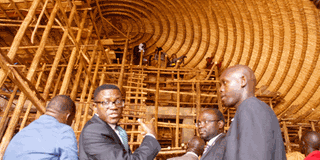Kasubi Tombs slowly rise from the ashes

Assessment. Buganda Katikiro Charles Peter Mayiga shows journalists the roof of the main house traditionally called “Muzibu Azaala Mpanga” during a tour of the ongoing construction works at Kasubi Royal Tombs in May 2017. PHOTO BY ABUBAKER LUBOWA.
What you need to know:
- Overdue. In 2010, then kingdom information minister Charles Peter Mayiga said the reconstruction works would last at least six months, meaning the tombs would have been completed by October the same year.
Kampala:
When fired gutted Kasubi Tombs on the evening of March 16, 2010, many assumed that reconstruction of this world heritage site would take just months. However, reconstruction has dragged on for seven years due to limited funds and cultural rites that needed to be performed first.
But if the latest assurance from the Buganda Kingdom anything is to go by, the refurbished burial grounds for the Buganda kings will be accessible to both local and foreign tourists starting next year.
Among the fallen kings buried at the tombs include Muteesa I, Mwanga II, Daudi Chwa II and Sir Edward Muteesa II.
Significant
The tombs have deep spiritual, political and religious significance for the Baganda and this explains why the United Nations Educational, Scientific and Cultural Organisation (Unesco) in 2001, listed them among the world heritage sites to be redeveloped. The site, located four kilometres west of the city and sitting on 64 hectares, is also a popular tourist attraction.
Buganda Kingdom information minister Noah Kiyimba says everything has been sorted, including miscommunication between stakeholders, cultural and financial issues and there is no more impediment in the construction works that have in the past seven years been moving at a slow pace.
Already, a perimeter wall around the tombs, lighting, a water source (constructed by the Mamba clan) and huts for the princesses, have been completed.
The Katikkiro (Buganda prime minister), Mr Chrales Peter Mayiga, revealed that the kingdom had picked the original photographs of the tombs from the Royal Geographical Society in the UK to enable engineers come up with a structure similar to the one that was burnt down.
Currently, the engineers are putting final touches on the roof of the main house traditionally called “Muzibu Azaala Mpanga,” the sepulcher where remains of four Buganda kings were buried, according to Mr Kiyimba.
Critical section
“The ceiling for Muzibu Azaala Mpanga has taken most of the time. They have to tie one reed onto another and they (reeds) are countless. But as I talk, about 80 per cent of the ceiling has been completed. In the coming month, we will be able to complete the roofing,” Mr Kiyimba said in an interview early this week.
He says another challenge has been collecting materials such as the thatch grass.
“In fact, the delay has partly been caused by the desire to erect a structure that matches international standards and can stand the test of time. The required grass is got from Hoima and collecting it is quite difficult, but we are moving on well and we shall finish all construction works soon,” Mr Kiyimba says.
Kabaka’s subjects managed to raise some Shs3b towards the reconstruction of the site, while government and foreign donors contributed Shs5b. President Museveni individually contributed Shs2b, bringing the total contributions to Shs10b.
However, on May 17, when the kingdom premier took journalists to inspect the ongoing reconstruction works, he indicated that they were still looking for an extra Shs2b to complete the work, implying that the entire project will cost Shs12b.
But critics say the budget for the project could have been inflated.
“What sophisticated materials have they procured to justify that expenditure? Shs12b is too much money, it can build a magnificent mall in the heart of the city, it is just sheer misappropriation of the funds because they know Baganda are kind people and willing to contribute any time they approach them,” a source in Buganda Kingdom, who preferred anonymity to speak freely about the matter, said.
The kingdom finance committee already indicated that it will release only Shs1.5b for the project, meaning Shs500m will still be needed.
The reconstruction works are currently under the direct supervision of the office of the Katikkiro.
“The weaving of the reeds that make up the ceiling is undertaken by members of Engeye (white monkey) clan and Engo (leopard) clan. They must be experienced, able to do the work,” Katikkiro Mayiga explained recently, adding that “reconstruction must follow different cultural norms, without observance of which, you cannot claim to be building tombs.”
The Kasubi Tombs reconstruction project manager, Mr Jonathan Nsubuga, says when the reconstruction is complete, the tombs will be a ‘gift to humanity’.
“We are really looking up to that day when we will unveil the refurnished tombs and I am sure everybody will appreciate the work and add Kasubi Tombs on the list of places one must visit at least once in their life time,” Mr Nsubuga says.
In 2010, when Mr Mayiga was still the kingdom information minister, he had projected that the construction works would last at least six months, meaning the tombs would have been completed by October the same year. When he assumed the office of Katikkiro in May 2013, Mr Mayiga set March 16, 2014 as deadline to complete the reconstruction.
According to the kingdom plan, the site is expected to be turned into cultural villages to attract more tourists, set up a tele-centre and a traditional tourist sanctuary.




